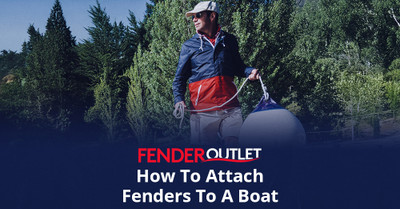19th Jun 2025
Fenders are essential equipment for any boat, whether you're mooring temporarily at a dock or rafting up alongside another vessel. Their main purpose is to prevent hull damage by absorbing the impact between the boat and other surfaces, such as pontoons, quays, and neighbouring boats. However, simply owning fenders isn’t enough - they must be correctly attached and positioned to be effective. Improperly tied or poorly placed fenders can fail to protect your boat, leading to costly scrapes or worse. This guide covers the key steps, techniques, and considerations for attaching fenders securely and using them effectively.
To begin, it’s important to understand the different types of fenders available. The most common for leisure boats are cylindrical fenders with eyes (reinforced holes) at one or both ends. These can hang vertically or horizontally depending on your setup. There are also round fenders (sometimes used on larger yachts or commercial vessels) and flat fenders or cushions designed for specific uses, such as narrow gaps or marina fingers. Regardless of type, the principles of attachment remain broadly the same.
The first step is to choose the correct fender ropes. These should be strong, weather-resistant ropes - typically made from braided polyester or nylon - and long enough to allow for flexible positioning depending on the height of the dock or the water level. A general rule of thumb is to use a line at least 1.5 times the height from your deck to the waterline. Always inspect your lines for signs of chafing or wear before use.
Next, decide where on your boat the fenders should be placed. The aim is to protect the widest and most vulnerable parts of the hull, which is usually midships and slightly forward or aft of that. If you're coming alongside a pontoon, place at least three fenders along the side: one near the bow, one amidships, and one at the stern. If the water is choppy or the dock is irregular, additional fenders should be used to cover more of the hull. For rafting up against another boat, align your fenders to meet their hull shape and protect both vessels evenly.
With the placement planned, you’re ready to attach the fenders. Start by choosing an appropriate fixing point on the boat. On most leisure boats, fender lines are tied to guardrails, stanchions, cleats, or dedicated fender eyes along the toe rail. The goal is to tie the fender line to something fixed and strong - avoid tying directly to thin guard wires or handrails that aren’t reinforced.
The most common and reliable knot for securing a fender line is the clove hitch, which can be tied quickly and adjusted easily. To tie a clove hitch, wrap the line around the rail or stanchion in a loop, then cross over and make a second loop, tucking the tail under the second wrap. The result is a secure yet adjustable knot that grips firmly under tension but can be repositioned as needed. If you're tying to a cleat, a round turn and two half hitches or even a bowline can be used for a more permanent attachment.
Once attached, adjust the height of each fender so that the lower third of the fender is touching the dock or the side of the adjacent boat. This ensures maximum surface area contact and the best protection. If fenders are hung too high, the hull can still make contact with the dock. If they’re too low, they may float uselessly in the water and provide no protection at all. It's important to recheck fender positions after tying up, as boat movement, tide changes, or wake from passing boats can shift them.
In cases where fenders need to be hung horizontally, for example, when covering a large flat surface or when rafting - tie the fender line to both ends of the fender and secure each end to your boat at different points, creating a horizontal orientation across the hull. This is particularly useful for protecting against boats with significantly different hull shapes.
When underway, fenders should be brought in and stowed. Leaving them hanging while cruising not only looks unprofessional, it can also lead to them becoming damaged, lost, or even caught in your prop or rudder in extreme cases. Most boats have dedicated fender baskets, lockers, or rails for this purpose. Keeping your fenders clean and stowed properly helps extend their life and prevents scuff marks on your topsides.
Finally, consider investing in fender socks if you’re concerned about cosmetic damage. These soft fabric sleeves go over your fenders to protect your gelcoat from abrasion and streaking, especially useful for darker-hulled boats where fender rubbing can leave visible marks.
In summary, correctly attaching and positioning your fenders is a simple but essential skill that protects your investment and ensures smoother, stress-free docking. Choose strong lines, secure them using proven knots like the clove hitch, and adjust the fenders so they sit at the right height and position for your particular docking situation. Regularly inspect both your fenders and lines for wear and reposition them as necessary depending on tide, wave conditions, or changes in dock height.



